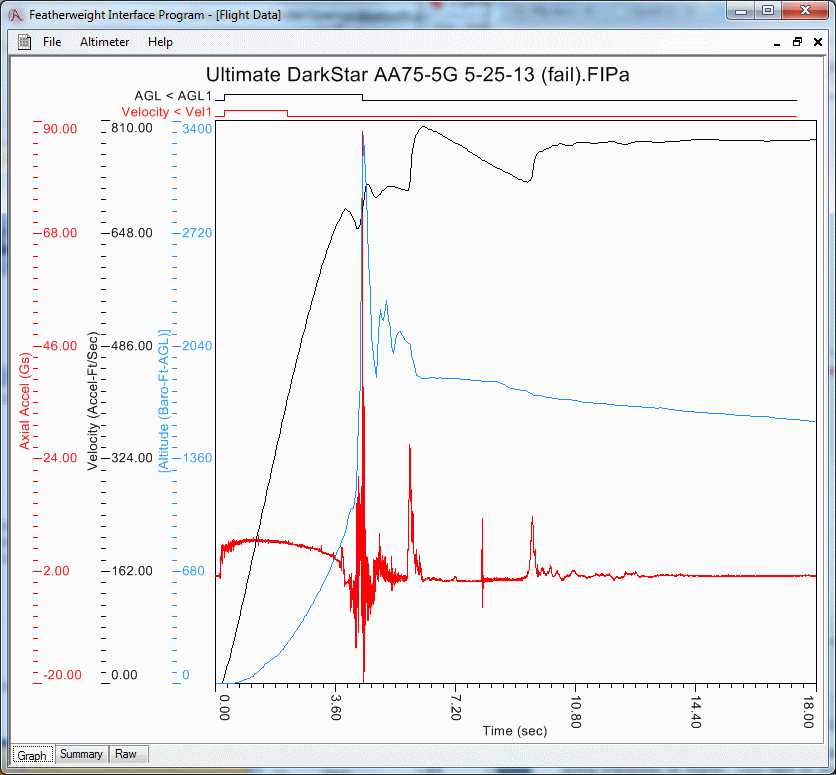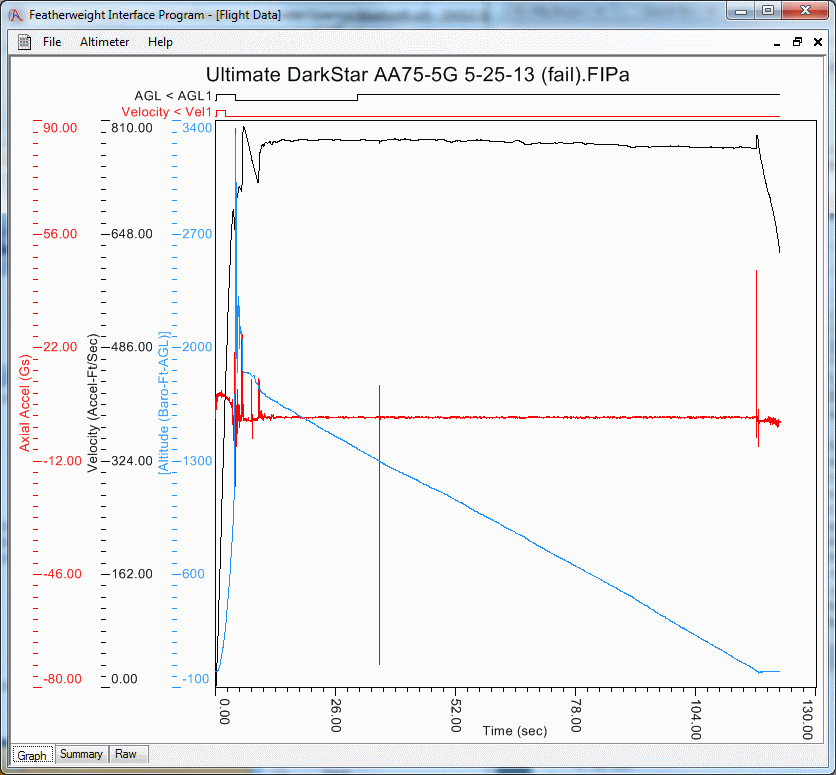Larry Curcio
Well-Known Member
- Joined
- Mar 5, 2009
- Messages
- 538
- Reaction score
- 3
Can anyone figure out this one??
Looks like a high speed deployment - maybe trans-sonic?

Can anyone figure out this one??
Does it sound like a good idea to post flight data files for all to see and share? This stuff fascinates me and I think there's a lot of learning to be had.Hi to all Raven owners (and potential owners)-
Sound good?
Can anyone figure out this one??
No charges fired before or during the breakup (based on the recorded continuity voltages). There is a big (20G) lateral impulse at 4.04 seconds, shortly before the breakup. Maybe a coupler failure?
No vehicle failure. Booster separated from the av bay because of front bulkhead blow by. My questions are; why no fired charges, why the speed increase past the "event" ?
I had a second alt, that's what fired all the charges.
By "front bulkhead blow by" do you mean motor forward closure blow-by?
Thanks for the insight on why the charges never fired. I guess that's why it is always important to run redundant electronics. The rocket would have been a 100% loss without the 2nd altimeter. I guess this would be a good time to re-calibrate the Raven. I plan on a Fathers day weekend flight on the same motor. I will post the data and hopefully a more successful flight.
Thanks again, Adrian.


Actually, the data from the main chute descent shows that you may not need a calibration. You should only re-calibrate it if the G readings with either end up are outside of 0.95-1.05 Gs.
And it's probably not true that the rocket would have been a total loss without the redundant altimeter; the fact that the main chute came out at apogee is why the Raven didn't fire its charges. Why is that?
Take a look at the Velocity Accel-Ft/sec plot, and follow it through the flight:

During the motor burn, the velocity quickly got up over the 400 foot/second threshold that the default settings use to determine when the rocket is going transonic or higher, (too fast to trust the baro readings). That happened at 2.18 seconds. At motor burnout when it had its high-speed separation, the rocket had about a half second of tumbling hash where sometimes the accel was pointed up and sometimes down, and in the net it couldn't tell that the velocity had come down a lot from the 700 feet/second it had before the breakup. Once the rocket stopped tumbling upward and started falling, if the Raven were the only electronics on board, the velocity estimate would have gradually dropped since it would no longer be measuring a steady upward 1 G. You can see this in the period between the two big accel spikes between 5 and 9.5 seconds when the main chute inflated.

From then on, the rocket was hanging upright from the main chute, and the Raven was measuring 1 G just like it was on the pad, so its velocity estimate didn't come much down until landing, when the rocket was on its side. If the main chute didn't come out at apogee, the Raven's velocity estimate would have gone down below the too-fast threshold after about 10 seconds and the Raven would have fired its charges then.
OK, back at the Tripoli Vegas Springfest launch (great time for those that missed it) I flew my two stage Wildman with a K815SK staging to a K160CL. The flight was, umm, interesting. First, the rocket weathervaned fairly badly during the booster burn. The stages separated (using the 3rd pyro channel set at 2nd stage at motor 1 burnout) successfully and the sustainer ignited using pyro 4 with a 2 second delay, Velocity > 500ft/sec, Pressure decreasing, and Height above pad > 576 ft. At burnout of the longburn K160, the rocket was more horizontal than vertical. The main deploy at approximately burnout. The apogee charge never burnt.
Now, looking at the data, it doesn't look like I ever made the triggers for the main (Height above pad < 480ft, pressure increasing, and Velocity < 400ft/sec, and after Motor 1 burnout.) Also, it appears there was voltage at the main channel the entire time? That doesn't make sense to me...
This is a version 1 Raven on a Power Perch using the standard LiPo for it. Surprisingly, there was no damage to the airframe, just a couple popped cords on the chute due to the stupid fast deployment.
Thoughts?
Droopy
View attachment 132971

Any one know why a Raven would only arm upside down?
I am not sure that there was a specific orientation required on any of the ravens.
Thanks in advanced, this should be a quick answer to my dumb question.
I did a little searching and came up with nothing.
Maybe the calibration is bad? There's a procedure in the documentation for recalibrating the accelerometer. I'd suggest trying that.
-Kevin
Anyone (Adrian) care to shed some light on what may have happened here at 63.75 (time)
Congrats. That looks great.Here's a flight of my Blue Falcon at this weekends
URRG launch.
I was hoping for 15k or more but, I'll take it.
It's also a new personal best.
JD
One guess is that your upper and lower sections were running into each other. Was this a drogueless setup? Did you see any dents or damage? There seems to be a lot of action on the way down to main deployment.


I just bench tested the Raven with an inert igniter (hand made, nichrome bridgewire, no pyrogen.)
All 4 channels can bring the nichrome to a nice orange glow at the appropriate time in the test routine.
From the FIPa data, it appears that the Velocity was "stuck" and never dropped below 400ft/sec required to fire the charges.
In fact, it shows that apogee was at 3333 MPH. I assure you this would have been a shred at that speed, not to mention in low earth orbit at 490k'
Why is the accelerometer so off? On the bench, the live data shows Axial and Lateral Gs at near 1.0 as expected for each position.
View attachment 141690
When you did the bench test that worked, was that with the altimeter installed in your av-bay the way it was for the flight?
Near zero Axial and lateral when laying flat, face up on the desk. On the sides Lateral is near 1, with axial near 0., flipping to the other side sees the values go negative and stay there (USB side down.)When you look at the live data readings and you flip the altimeter over 180 degrees, so you see -1G until the sign convention is flipped? When it's on its side, does it read near 0?
Looking at your data more closely, I see that in the first part of the flight, the data looks sort of plausible except that during the coast period, there is a steady +6-+7G reading. This is what you get when the accelerometer's test mode is activated, which is possible if some conductive material touches the wrong pin. The hash we see later in the flight could be from contact with adjacent pins.
Two Ravens on board, same flight, dramatic difference in data
primary is Raven3 70g
secondary is Raven2 250g
clarification on high gees upon landing-main chute did not entirely inflate
Enter your email address to join: